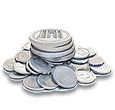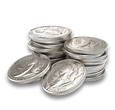The Role of Historical Events in Driving Coin Prices
- GoldsilverJapan

- Sep 26
- 6 min read
In the world of numismatics and precious metal investing, coin values are never determined in a vacuum. While metal content, mintage, and rarity certainly play important roles, historical events have always had a powerful influence on both the collectible and bullion coin markets.
From ancient wars that altered empires to modern financial crises that disrupted economies, coins are not just currency—they are living artifacts of the time they were minted and traded. This article explores how major historical moments—wars, economic collapses, revolutions, and policy shifts—have shaped coin prices, both in the short and long term.
🕰️ 1. Historical Events as Value Catalysts
Why Do Historical Events Matter?
When you buy or collect a coin, you're not just acquiring a piece of metal. You're buying a story, a physical token of a moment in history. This is especially true for numismatic coins—those valued for more than just their metal content.
Historical events drive coin prices by:
Increasing demand for coins with historical connections
Limiting supply (e.g., melting, war destruction)
Altering metal availability and minting policies
Creating emotional and cultural resonance
Let’s break this down further by event category.
⚔️ 2. War and Conflict: Coinage in Times of Crisis
Throughout history, wars have altered coin values in multiple ways.
A. Civil War (USA)
During the American Civil War (1861–1865), the U.S. Mint suspended silver coinage, and hard currency became scarce. People hoarded coins, especially gold and silver, which led to the rise of paper money and tokens. Today, Civil War-era coins, especially gold and fractional currency, command high premiums.
B. World War I & II
Gold coinage virtually vanished from circulation during WWI, and by WWII, many nations shifted from gold/silver coinage to base metals like zinc or aluminum due to war demand. As a result:
Pre-War gold and silver coins are highly prized today.
Wartime emergency coinage, like steel cents (USA, 1943), carry historical significance and collector appeal.
C. Nazi Germany
Coins from Nazi Germany (1933–1945) are controversial but still draw strong collector interest due to their historic weight. The swastika-bearing 2 and 5 Reichsmark silver coins, while once common, are now rare in high grades.
💸 3. Economic Collapses and Hyperinflation
A. Weimar Republic (Germany, 1920s)
Germany’s post-WWI economy spiraled into hyperinflation. Marks were printed in billions, and metal coins were replaced by paper or token coinage. Today:
Coins from the Weimar era are collectible as hyperinflation relics.
Gold coins minted just before the collapse (like 20 Mark gold coins) are considered safe havens.
B. Great Depression (1930s)
During the Great Depression, many world mints reduced coin production:
Low-mintage coins from the 1930s often carry significant premiums today.
The 1933 Double Eagle ($20 gold coin) is one of the most expensive coins ever sold, partly because of its mysterious story and restricted legality.
🏛️ 4. Political Upheaval & Regime Changes
Whenever a new regime takes power—whether via revolution, dissolution, or independence—coinage is one of the first things to change.
A. Russian Revolution (1917)
Pre-Soviet coins from Imperial Russia are very collectible, especially gold roubles from Tsar Nicholas II. After the revolution, coins were redesigned, and many old coins were melted or destroyed—creating scarcity.
B. Collapse of the Soviet Union (1991)
The early 1990s saw an explosion of commemorative coinage from Russia and former Soviet republics. Collectors seek coins marking the end of the USSR, including:
1991–1993 transitional ruble coins
Coins issued by breakaway republics like Ukraine and Kazakhstan
🌍 5. Cultural & Social Movements
Certain historical events ignite cultural pride or awareness, boosting interest in coins related to those causes.
A. Civil Rights Movement (USA)
Modern coins commemorating Martin Luther King Jr., the Selma March, and other civil rights icons have grown in demand. These may be modern issues, but their historical significance gives them lasting appeal.
B. Royal Events
British coins often see price spikes during major royal events:
Queen Elizabeth II’s coronation (1953) and passing (2022)
King Charles III’s ascension
Jubilee editions (Golden, Diamond, Platinum)
These events trigger both sentimental and speculative demand.
🏆 6. Olympics, Expositions, and National Celebrations
Coins minted for global or national events often spike in price depending on the popularity of the event or limited mintage.
Examples include:
1964 Tokyo Olympics Silver 100 Yen Coin
1976 Montreal Olympics silver commemoratives
2008 Beijing Olympics Gold & Silver series
Coins tied to globally recognized milestones can enjoy enduring demand.
📉 7. Policy Shifts That Affected Coin Prices
A. The End of the Gold Standard (1971, USA)
When President Nixon decoupled the U.S. dollar from gold in 1971, the value of physical gold soared over time. Coin collectors began shifting toward bullion-oriented gold and silver coins like:
American Gold Eagles
Canadian Maple Leafs
Krugerrands
B. Introduction of Euro (1999–2002)
The Euro’s introduction led to the retirement of multiple national currencies. Coins from the final years of:
German Marks
French Francs
Italian Lira
...became nostalgic artifacts, especially in proof or mint-state condition.
💰 8. How Coin Investors Can Use History Strategically
If you’re a collector or investor, understanding how historical events affect coin values allows you to:
Anticipate future price movements
Spot undervalued coins tied to historic eras
Diversify with coins from multiple timelines and regions
Tips:
Look for coins tied to eras of limited production (war, crisis, transition).
Consider coins from emerging economies undergoing political change.
Watch for coins linked to anniversaries—they often see renewed interest during commemorations (e.g., 100 years since WWI, 50 years since moon landing).
📊 9. Coin Price Spikes During Major Events
Let’s review a few historical moments that triggered massive value surges in specific coins—whether due to scarcity, symbolism, or renewed interest:
Event | Coin | Result |
9/11 (2001) | American Silver Eagles | Sales surged; seen as a safe haven during crisis |
COVID-19 Pandemic (2020) | Gold Britannias, Silver Maples | Demand skyrocketed; supply chain issues pushed premiums |
Brexit Vote (2016) | British Coins | Spike in demand for Royal Mint and older sovereign issues |
Russian Invasion of Ukraine (2022) | Ukrainian Hryvnia Commemoratives | Increased global interest and national pride fueled collector demand |
Ancient Rome | EID MAR Denarius (42 B.C.) | Minted by Brutus to commemorate Caesar’s assassination; one sold for over $4 million in 2020, becoming one of the most valuable ancient coins ever |
Ex-King Farouk Collection (1950s) | 1933 Double Eagle ($20 gold coin) | Once part of Egypt’s King Farouk's controversial and world-famous collection; resurfaced decades later and sold for a record-breaking $18.9 million in 2021, in part due to its royal provenance and legal history |
🧠 10. Psychological Value of History
Coins that carry emotional weight—such as survival from war, marking freedom, or symbolizing unity—often attract a strong community of collectors.
This demand goes beyond metal value. It’s about identity, legacy, and history.
📚 11. Case Studies: Specific Coins Affected by History
A. 1933 Saint-Gaudens Double Eagle
Minted just before Roosevelt outlawed gold ownership
Most were melted; only a few survived
One example sold for $18.9 million in 2021
B. Japanese Occupation Currency (1940s)
Coins issued during Japan’s occupation of Southeast Asia (Malaya, Philippines, Indonesia) are highly collectible—symbolizing colonial conflict and post-war recovery.
📈 12. Gold & Silver Bullion Prices During Crises
While not strictly numismatic, it’s worth noting that bullion coin prices are heavily influenced by global crises.
Examples:
2008 Global Financial Crisis: Gold surged, pushing demand for bullion coins like the American Gold Eagle.
2020 COVID-19: Premiums on bullion coins soared due to shutdowns at mints and rising demand.
🔁 13. The Cyclical Nature of History and Coins
Just like markets, history is cyclical. Periods of calm are often followed by disruption. Coin investors can prepare by:
Studying historical parallels (e.g., 1970s inflation vs. 2020s)
Owning coins tied to past crises
Holding physical coins as hedge assets
🛡️ 14. Why Collectors Value Historical Coins More Than Bullion
Historical coins tell a story.
They evoke:
The identity of a nation
The struggles of a people
The artistry of a bygone era
That emotional and educational value adds an intangible premium to many historical coins—making them ideal for collectors with long-term views.
🧭 15. Conclusion: Navigating Coin Prices Through History
Coin values are intricately tied to the tides of history. Whether you're a collector, investor, or hybrid of both, understanding the historical context of a coin gives you a serious advantage.
Key takeaways:
War, crisis, and policy changes often limit supply and spike demand
Coins tied to iconic events often outperform generic bullion
Emotion, nostalgia, and symbolism drive collector demand
You can hedge your portfolio by owning coins from diverse time periods and regions
In an unpredictable world, coins offer a tangible link to the past and a secure path into the future.











Comments